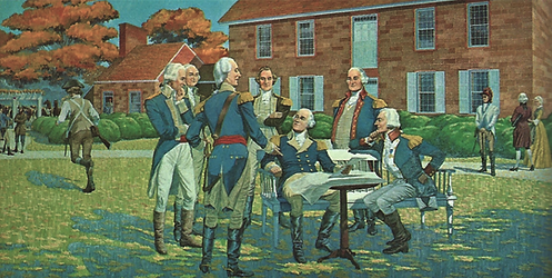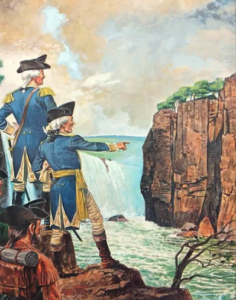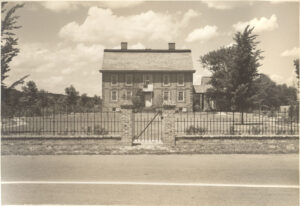Dey Family
The Dey Mansion, built ca. 1770, was the home to Theunis and Hester Dey and served as General George Washington’s headquarters during July, October, and November of 1780.
The Dey family was one of prominence, with roots in the American colony dating back to 1641, when Dirck Janszen Siecken Dey, a soldier with the Dutch West India Company, arrived in New Amsterdam (New York). In 1674, after the English had captured most of New Amsterdam, Dirck Siecken was on a list of the best and most affluent inhabitants of the colony.
More than four decades later his grandson, also named Dirck, purchased from the heirs of a man named Thomas Hart six hundred acres at Preakness, now Wayne Township, New Jersey. The land passed to his son Theunis Dey in 1764 and at the time of his inheritance, he was a thirty-eight (38) year old, a married father of nine children. He took up a prominent role in public life representing Bergen County in the State Council and was a charter trustee of the Queen’s College (now Rutgers, the State University).
As Washington’s Headquarters

The Dey Mansion is one of General Washington’s military field headquarters
still standing today. During the American Revolution, Theunis Dey served as colonel of the Bergen County Militia, which brought him into constant communication with Washington.
Historian Isaac A. Serven explained the Dey-Washington relationship in this way: “Besides sharing ideals of liberty and military secrets, they had other interests in common. Both were nearly the same age, both were large landowners and agriculturalists, and both had served in a civil capacity in the governing bodies of their respective counties and states.”
In a military context, the “vicinity of the Passaic Falls” was chosen for the encampment of Washington’s forces because of its strategic position and accessibility to food and forage.
General Washington occupied the mansion, which Colonel Dey called “Bloomsbury,” from Saturday, July 1 to Saturday, July 29, 1780. The commander-in-chief again made the mansion his headquarters from Sunday, October 8 to Monday, November 27, 1780.
The only military incident directed by Washington in July was an attack on Bull’s Ferry by Brigadier General Anthony Wayne. On July 14, Washington received news that the French allies had arrived at Newport, Rhode Island. The commander-in-chief made preparations to meet with them and left on July 29, 1780.
Between July 29 and his return on October 8, 1780, Washington was campaigning in the Hudson Highlands, conferring with the French, and dealing with “treason of the blackest dye” within his own ranks.
At the end of September, Major-General Benedict Arnold’s traitorous conduct was revealed. Arnold’s accomplice, Major John André, was hanged on October 2 at Tappan, New York. The British commander, Sir Henry Clinton, wanted to avenge André’s execution by seizing Washington himself. The commander-in-chief decided to move his army to the less accessible Preakness Valley.

During the October-November encampment, two military enterprises occurred. A failed attack on Staten Island was made under the direction of Major General Lafayette.
In the second maneuver, reconnoitering parties under the command of Lafayette, Moylan, and Humphrey advanced toward Fort Lee in contemplation of an attack on Fort Washington. The commander-in-chief discontinued the operation.
On November 27, 1780, Washington left the Dey Mansion, and part of his troops moved to Morristown; a few of the Pennsylvania and New Jersey regiments were cantoned at Pompton.
Among the Washington papers at the Library of Congress are documents that attest to the Dey Mansion’s significance as a military headquarters. There are 364 letters and orders totaling 594 pages that were written at the mansion, by and on behalf of General Washington to army officers and the Continental Congress.
While in residence at the mansion, Washington received 610 communications numbering 1,275 pages.
Dey Mansion Afterwards

General Richard Dey, Colonel Dey’s eldest son, sold the homestead and 335 acres of land in 1801. From then on, various private owners possessed the mansion and surrounding acreage until January 10, 1930, when it was acquired by the Passaic County Park Commission.
During the winter of 1933-34, it was restored under the supervision of Charles Over Cornelius, architect and former associate curator of decorative arts at the Metropolitan Museum of Art. The Dey Mansion was opened to the public on October 8, 1934.
In 1970 the Dey Mansion was entered on the New Jersey and National Register of Historic Places. In 2010, the Passaic County Board of Chosen Freeholders began a comprehensive project to further restore and rehabilitate the Mansion.
This project was funded by the New Jersey Historic Trust and the Freeholders’ Open Space, Farmland, and Historic Preservation Trust Fund.

